- Home
- About
- Map
- Trips
- Bringing Boat West
- Migration West
- Solo Motorcycle Ride
- Final Family XC Trip
- Colorado Rockies
- Graduates' XC Trip
- Yosemite & Nevada
- Colorado & Utah
- Best of Utah
- Southern Loop
- Pacific Northwest
- Northern Loop
- Los Angeles to NYC
- East Coast Trips
- 1 Week in Quebec
- Southeast Coast
- NH Backpacking
- Martha's Vineyard
- Canadian Maritimes
- Ocracoke Island
- Edisto Island
- First Landing '02
- Hunting Island '02
- Stowe in Winter
- Hunting Island '01
- Lake Placid
- Chesapeake
- Provincetown
- Hunting Island '00
- Acadia in Winter
- Boston Suburbs
- Niagara Falls
- First Landing '99
- Cape Hatteras
- West Coast Trips
- Mojave 4WD Course
- Colorado River Rafting
- Bishop & Death Valley
- Kauai
- Yosemite Fall
- Utah Off-Road
- Lost Coast
- Yosemite Valley
- Arizona and New Mexico
- Pescadero & Capitola
- Bishop & Death Valley
- San Diego, Anza Borrego, Joshua Tree
- Carmel
- Death Valley in Fall
- Yosemite in the Fall
- Pacific Northwest
- Utah Off-Roading
- Southern CA Deserts
- Yosemite & Covid
- Lake Powell Covid
- Eastern Sierra & Covid
- Bishop & Death Valley
- Central & SE Oregon
- Mojave Road
- Eastern Sierra
- Trinity Alps
- Tuolumne Meadows
- Lake Powell Boating
- Eastern Sierra
- Yosemite Winter
- Hawaii
- 4WD Eastern Sierra
- 4WD Death Valley +
- Southern CA Deserts
- Christmas in Tahoe
- Yosemite & Pinnacles
- Totality
- Yosemite & Sierra
- Yosemite Christmas
- Yosemite, San Diego
- Yosemite & North CA
- Seattle to Sierra
- Southwest Deserts
- Yosemite & Sierra
- Pacific Northwest
- Yosemite & South CA
- Pacific Northwest
- Northern California
- Southern Alaska
- Vancouver Island
- International Trips
- Index
- Tips
- Books
- Photos/Videos
- Search
- Contact
Kodachrome Basin State Park, UT
Sunday, September 17, 2023 - 1:30pm by Lolo
48 miles and 1 hour from our last stop - 1 night stay
Travelogue
 Big Stoney in all its majestyKodachrome Basin is another one of Utah’s incredible state parks. As with Goblin Valley, and the Boulder Mountain Lodge, I was very lucky to have gotten a last-minute reservation, allowing us to set a framework for our travels through Utah.
Big Stoney in all its majestyKodachrome Basin is another one of Utah’s incredible state parks. As with Goblin Valley, and the Boulder Mountain Lodge, I was very lucky to have gotten a last-minute reservation, allowing us to set a framework for our travels through Utah.
Although best known for its beautiful red rock, Utah’s parks have much more, and each park has its own unique geological features.
Kodachrome’s unique feature is its 67 multicolored rock spires, known as sand pipes, which appear nowhere else in the world.
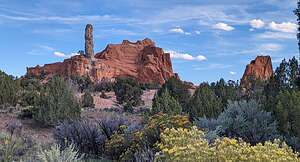 Heading out on the Panaorama TrailGeologists believe that these sand pipes are solidified sediment that filled ancient geysers and springs and were left standing after the softer sandstone surrounding it eroded away. They vary in size from 6 feet to nearly 170 feet high and their colors vary from soft whites and yellows to more dramatic pinks and reds.
Heading out on the Panaorama TrailGeologists believe that these sand pipes are solidified sediment that filled ancient geysers and springs and were left standing after the softer sandstone surrounding it eroded away. They vary in size from 6 feet to nearly 170 feet high and their colors vary from soft whites and yellows to more dramatic pinks and reds.
The most prominent and by far the most interesting sand pipe is the very large, anatomically correct, phallus-shaped one that overlooks the campground. And as if that wasn't amusing enough, its name is "Big Stoney."
 Indian CaveThere are six hiking trails in the park, most of them less than 1 mile in length, except for the Panorama Trail, a 3-mile loop through what is probably the best and most varied scenery in the park.
Indian CaveThere are six hiking trails in the park, most of them less than 1 mile in length, except for the Panorama Trail, a 3-mile loop through what is probably the best and most varied scenery in the park.
Back in 2003 when we were here with our then 11 and 13-year-old sons, we mountain biked this trail. It’s the only trail in the park where mountain bikes are allowed. Well, today, we would revisit it, this time on foot and without kids. Wow! Twenty years. I still can’t believe that.
The scenery was amazing right from the start. We weren’t more than 100 yards from the trailhead before he came to a beautiful red-orange Entrada Sandstone rock formation with a large white chimney-like sand pipe rising from it.
 Handprints on Indian CaveGeologists think that this was once a geothermal area with hot springs and geysers. After they stopped flowing, they filled with sand. These are the white spires (sand pipes) we were looking at today. They are composed of coarse sand, which is far more resistant to erosion than the overlying orange Entrada Sandstone, so that is why so many of them remain. It was amazing to think that this is the only place in the world where they can be found.
Handprints on Indian CaveGeologists think that this was once a geothermal area with hot springs and geysers. After they stopped flowing, they filled with sand. These are the white spires (sand pipes) we were looking at today. They are composed of coarse sand, which is far more resistant to erosion than the overlying orange Entrada Sandstone, so that is why so many of them remain. It was amazing to think that this is the only place in the world where they can be found.
Already the hike was worthwhile and we had only gone 0.1 miles. At 0.3 miles we came to a fork and took a right, going the recommended counter-clockwise direction around the loop.
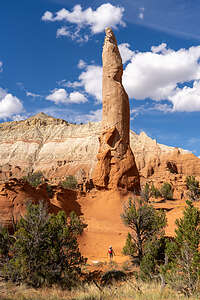 Ballerina SlipperAt 0.7 miles we came to Indian Cave, a small rock overhang just a short distance off the path. It was thought to have been inhabited by Native Americans.
Ballerina SlipperAt 0.7 miles we came to Indian Cave, a small rock overhang just a short distance off the path. It was thought to have been inhabited by Native Americans.
The interesting feature of this cave was a row of handprints adorning the outside wall of the cave. These were very different from the pictograph 100 Hands we had seen earlier in the day. These were deep grooves (handprints) carved into the wall, which makes them a petroglyph rather than a pictograph. Some are very deep while others are just shallow indentations.
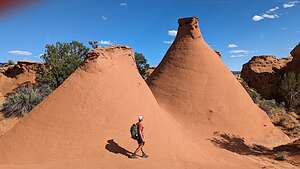 Teepee rocks in the Secret PassageThere was no signage explaining the handprints, so they might not have been made by Native Americans. In either case, they were very interesting.
Teepee rocks in the Secret PassageThere was no signage explaining the handprints, so they might not have been made by Native Americans. In either case, they were very interesting.
The next feature of note along the trail was the Ballerina Slipper, a tall, graceful sand pipe, resembling a ballerina en pointe (fancy word for on her toes).
Next came the Hat Shop, a collection of hoodoos, one of which looked like it was wearing a baseball cap - a bit of a stretch.
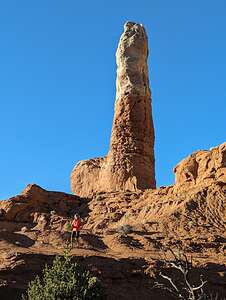 Morning visit to Big StoneyAt around 1.5 miles we came to the “Secret Passage,” a 0.3-mile spur loop over a small slickrock divide between the high cliffs. I’m so glad we took this little spur trail, because one of the highlights of the entire hike was a collection of teepee-like rocks, so smooth and perfectly cone-shaped that they seemed man-made.
Morning visit to Big StoneyAt around 1.5 miles we came to the “Secret Passage,” a 0.3-mile spur loop over a small slickrock divide between the high cliffs. I’m so glad we took this little spur trail, because one of the highlights of the entire hike was a collection of teepee-like rocks, so smooth and perfectly cone-shaped that they seemed man-made.
We skipped the additional side trails to Cool Cave and Panorama Point, which would have added another 3 miles to our hike.
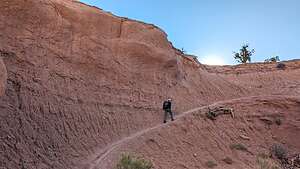 Sunrise start on the Angel's Palace TrailIt was already around 5:00, and we were anxious to get back to the campground and settle in. It had been a very full day already, with the hike to the 100 Hands Pictograph, the drive down Hole-in-the Rock road to the Devil’s Garden, and now this.
Sunrise start on the Angel's Palace TrailIt was already around 5:00, and we were anxious to get back to the campground and settle in. It had been a very full day already, with the hike to the 100 Hands Pictograph, the drive down Hole-in-the Rock road to the Devil’s Garden, and now this.
So, all in all, a 3.75-mile hike with lots of great and varied scenery along the way.
The campground was very nice, 27 sites set in a natural amphitheater right by “Big Stoney.” Like Goblin Valley State Park, the bathrooms had wonderful showers, nicer than the one I have at home.
 Entrada Sandstone along the Angel's Palace TrailI slept very well that night, listening to the patter of rain on the roof of the 4Runner. By morning the rain was gone and we had clear blue skies.
Entrada Sandstone along the Angel's Palace TrailI slept very well that night, listening to the patter of rain on the roof of the 4Runner. By morning the rain was gone and we had clear blue skies.
Before leaving the campground for another hike in the park, we took a stroll around the campground. I tried to climb up and get as close to Big Stoney as I could. He’s even bigger up close.
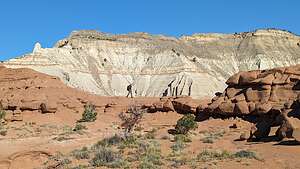 Along the Angel's Palace TrailThis morning, before leaving the park, we decided to hike the Angel’s Palace Trail, probably the second most popular hike in the park, after the Panorama Trail, which we did yesterday. The two trailheads are right across the road from each other.
Along the Angel's Palace TrailThis morning, before leaving the park, we decided to hike the Angel’s Palace Trail, probably the second most popular hike in the park, after the Panorama Trail, which we did yesterday. The two trailheads are right across the road from each other.
The beginning of the hike was along a mostly flat sandy path. After about a quarter of a mile, we entered a small canyon lined with beautiful orange Entrada sandstone and began to climb for about 150 feet up the left-side wall of the canyon, eventually switchbacking over to the right.
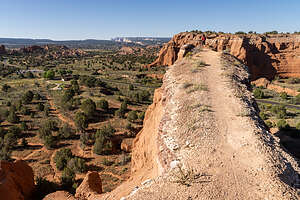 Promontory out to an awesome viewThe trail flattens out as the top of a ridge and becomes somewhat hard to follow, so we just wandered wherever it looked interesting. We knew we would get lost because we had enough technology (Gaia, Strava, Google Maps) to land on the moon.
Promontory out to an awesome viewThe trail flattens out as the top of a ridge and becomes somewhat hard to follow, so we just wandered wherever it looked interesting. We knew we would get lost because we had enough technology (Gaia, Strava, Google Maps) to land on the moon.
We eventually came to a short spur trail that led out to a long promontory overlooking the entire basin below. The trail out along the promontory was at least a sidewalk's width, so it shouldn’t be a problem unless you have a real fear of heights.
From the end of the promontory there was a great view of the entire basin below - Entrada badlands to the north, a cluster of small buttes and sand pipes to the south, and an extensive outcrop of red sandstone to the west.
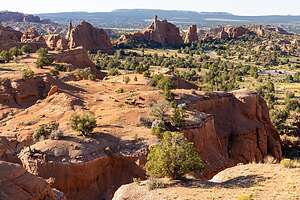 Views from the Angel's Palace TrailPlus the rising sun was now illuminating the tops of the jagged formations to the west.
Views from the Angel's Palace TrailPlus the rising sun was now illuminating the tops of the jagged formations to the west.
A lot of bang for our buck on a 1.66 mile hike with just a 260-foot elevation gain. What a great way to start the day!!
Kodachrome was originally supposed to be our last stop before heading home, 14 hours away. That was until we realized Bryce Canyon National Park was only a half hour away and along our route home. How can anyone pass up such an easy visit to Bryce.
So we checked the Lodge and the Campground in Bryce, but they were totally booked. So, we did the next best thing - book a room at Ruby’s Inn, the closest lodging to the park just a 3-mile drive to the Visitor Center. This would allow us to get into the park for both sunset and sunrise.
So what if we got home a day later. That's the good part (one of many) of being retired.
- ‹ previous
- 13 of 16
- next ›
Kodachrome Basin State Park location map in "high definition"
Javascript is required to view this map.
